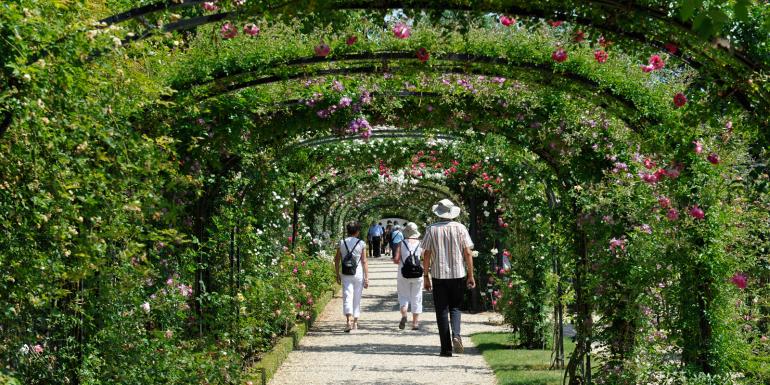
An important step in the Art of Gardens
The work of Edouard André and of Jules Gravereaux and subsequently his son Henri, is historically important because they were the creators of an exceptional garden : the first garden entirely dedicated to roses. 1910 is thus a momentous year in the Art of Gardens.
“It’s here that we could see, for the first time, all the resources that the rose offers to garden decoration. This was a revelation, almost a revolution”. Henri Gravereaux.
Indeed, the “garden dedicated to roses” marks an important stage in the history of gardens. The first single-species garden, it showed that a garden made up of a collection could also be a garden for pleasure and that the diversity of the rose itself, allows for the creation of a garden : bush roses, rambling roses, treelet roses, but also sarmentose and climbing roses trained along frames such as pergolas, arcs, garlands and towers. Thus the rose creates volume, emphasises perspectives and decorates the garden. The central of the Roseraie, designed by Henri Gravereaux and called “the garden of the most beautiful roses” (photo opposite) is an excellent illustration of this : It is a stylistic exercise in reinterpretation of the garden à la française with the help uniquely of roses. Édouard André and the Gravereaux, father and son, thus invented a new style of garden : “the Roseraie”.
The style of the Roseraie fits in with that of the “garden dedicated to roses” initially designed by Édouard André : the rigour of the formal garden, the search for the optimal decorative qualities of the rose through the use of varieties, of doors, of different supports, the association of architectural elements, of sculpture and the return to the vocabulary of the classical garden : the dome, pergolas, the Temple of Love), busts mounted on pedestals, etc. However, the decorative elements, chosen in direct relation with the roses presented, characterise the originality of each garden and enrich the decorative aspect of the 1910 Roseraie.
The bust of Joséphine, for example, is placed at the entrance to the Malmaison Alley ; the Oriental Rose Garden has the most developed character : the supports are in bamboo, the beds - bordered with boxwood in the other gardens - are here outlined with stones, two ceramic dragons guard the entrance to the garden ; the Gallic garden dedicated to roses adopts the rustic style of its neighbour, the Horticultural Rose Collection Garden and so on.
The harmony of the 1910 Roseraie arises from this duality between the unity of treatment of the whole of the plan inspiring grandeur and solemnity and the fantasy brought in by specific treatment of the decorative elements of each garden. A decorative garden, of pleasure and of beauty, a scholarly garden, of demonstration of the variety of the genus Rosa and of study, the Roseraie appears thus to be a complete work, a perfect balance : it offers a journey through time and space, a panorama of the evolution of the rose down the ages, it satisfies all the senses, the heart and the mind.
The remarkable nature of the garden has been recognised : the Roseraie du Val-de-Marne has been included in the supplementary list of historic monuments : below is the official description classifying it as such.
Inclusion is reserved for sites whose value or fragility do not justify classification (in the main list) but have sufficient interest for their future to be monitored. Inclusion therefore establishes the landscape interest of the Roseraie du Val-de-Marne and the wish to attend to the qualitative management of its future.
In concrete terms, the Roseraie in situ is not in danger. However, plans concerning its environment (in particular the plans to re-designate the town centre with the restructuring of the church square opposite the park entrance) are the subject of particular attention.




